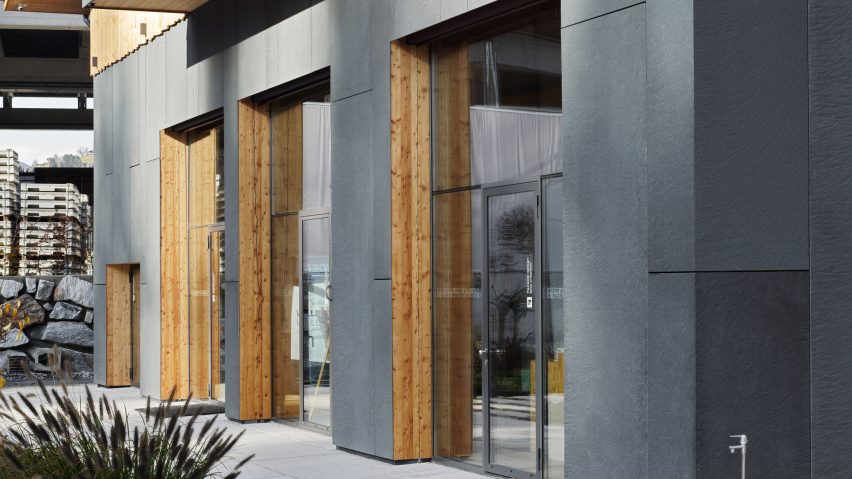Promotion: Austrian cladding company Rieder is developing facade panels with reduced cement content – informed by the buildings of ancient Rome – which it has used across its headquarters with the aim of becoming "climate positive" by 2030.
Rieder is replacing cement in its concrete facade panels with natural and local pozzolana – a material derived from volcanic matter such as pumice or ash that has lower CO2 emissions during its production than concrete with high cement content.
"Concrete without cement, is that possible? Yes, Wolfgang Rieder firmly believes, and he has sent his company on a journey with 'climate positive by 2030' as the destination," said Rieder.
Through the development of CO2-reduced facade panels, Rieder is introducing a reduced-cement composition across its existing products including its Material fibreC, concrete skin, öko skin and formparts.
To better understand the products and their durability, Rieder is trialling the usage of its cement-reduced Material fibreC panels across a 400-square-metre facade area on the exterior of its headquarters in Maishofen, Austria.
"We have identified the levers where we can intervene in order to produce and operate climate positively by 2030," said Rieder founder Wolfgang Rieder.
"Now we are implementing our plan, evaluating the results and developing them further."
Already, the facade company has replaced 50 per cent of cement used in the concrete mix with alternate materials, such as pozzolana, which has produced a product that reduces CO2 emissions by 30 per cent.
According to the Austrian cladding company, its use of natural pozzolana was informed by the Romans and their construction techniques specifically in developing opus caementicium – a cast masonry or concrete used to build ancient Rome.
Rieder says that the Romans used pozzolana as a binder in opus caementicium, which reduced cracking across the material and provided the cast masonry with better durability than modern concrete – as evident through Rome's, still standing, Pantheon, Colosseum and Roman forum.
"The cement used in the Rieder facade panels is gradually being replaced by natural and local pozzolana, which has significantly lower CO2 emissions during production," said the brand.
"Inspired by ancestral knowledge and driven by the will to minimise the company's ecological footprint and offer products that help bring about a climate reversal, Rieder developed a world first," it continued.
The facade panels with reduced cement content and CO2 emissions, including concrete skin, öko skin and formparts, will be available in 2023 and in a selection of colours including a slate finish, which bears similarities to real slate.
By 2027, Rieder hopes its facade panel product range will be completely cement-free.
The company's new headquarters, Glemm21 in Maishofen, was transformed from a former bus garage into a workspace for Rieder in an attempt to serve as an example of circular construction.
In the renovation, Rieder reused concrete columns, 150 tonnes of recycled steel and wooden walls within the headquarters to create a workspace that spoke to the ethos of their climate-positive goals.
"Using what's there already rather than building something new is known to be the best way to save grey energy and reduce land sealing. And so, we tried it out on ourselves", said Wolfgang Rieder.
Through renovating and not rebuilding, it is estimated that Rieder will have saved around 1,000 tonnes of CO2 by opting out of building a new structure.
To learn more about Rieder and its facade panels visit its website.
Partnership content
This article was written by Dezeen for Rieder as part of a partnership. Find out more about Dezeen partnership content here.

